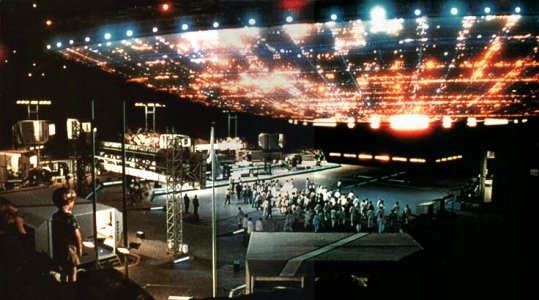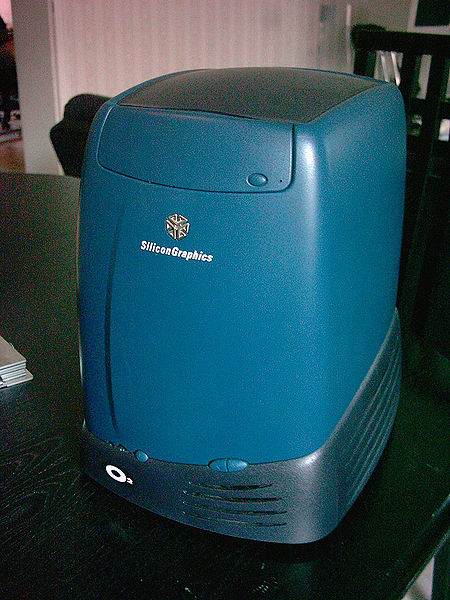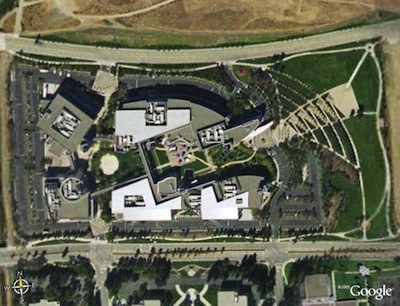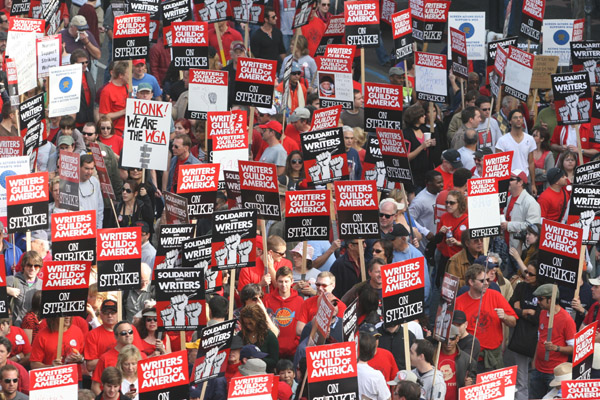In 2003, when the vote happened, I forget what the actual vote tally was, but it was in the area of 10 ‘Yes’ votes to 500 ‘No’ votes. I was actually embarrassed for them. Now, to people who know me and my views on labor rights for VFX artists, they might find it surprising that I was one of those that voted ‘no’. They might find it even more surprising that I would still vote ‘no’ today.
VFX no more belongs with feature animation than it does with art directors, makeup, or acting. Just because people use the same tools to do their job, doesn’t mean they do the same job. Multiple unions have protected the same people doing the same job for years.
SAG and
AFTRA have coexisted side by side, though soon they may merge. Perhaps a better example would be SAG and
Actors Equity. One represents the needs of film actors, the other actors on the stage. Many actors belong to both. No conflict.
VFX needs something new. VFX needs something of their own. Before we can talk about the future, let’s take a look at how we got to where we are.
Many people think the modern VFX industry began with Star Wars and I
ndustrial Light & Magic in 1975. This is not entirely accurate. When George Lucas went to make Star Wars, he discovered that 20th Century Fox had shut down their visual effects department. Up until then, studios had their own in house divisions to handle VFX. Same with sound, wardrobe, make-up, etc. But with the break up of the studio system during the 70’s, coupled with the type of movies being made at the time, having a visual effects department wasn’t necessary. So George Lucas formed his own group, which would become ILM All this is covered amazingly well in
“Industrial Light & Magic: The Art of Special Effects” by Thomas G. Smith and
“The Making of Star Wars” by J.W. Rinzler. [CORRECTED] At the same time as Star Wars was being worked on, another group was doing Close Encounters of the Third Kind for Steven Spielberg. I always think of Encounters as an ILM movie, but it wasn’t. It was a group of people working directly for the production.
 Not ILM
Not ILM
ILM as we know it today - sort of, but we’ll get to that soon - formed in 1978 to do The Empire Strikes Back. But the real key moment was their second project as the new ILM - Raiders of the Lost Ark. Both Star Wars and Empire were done for 20th Century Fox under the auspices of Lucasfilm. Raiders was still a Lucasfilm production, but for Paramount. They made a few more films for Paramount, before MGM and Universal and suddenly the VFX Vendor System was how we worked. This system is the fundamental flaw to visual effects as a business, though it did not become apparent for many years.
For a while, ILM was pretty much the only game in town. Even if their town was 400 miles north of Hollywood in Marin County. Eventually other companies would form -
Boss Film,
Dream Quest, et cetera, and the bidding process was born. When a movie required visual effects, the production company - now independent of the studio system - would take their script, storyboards, and other design elements to the visual effects companies.
Knowing the scope of the work and what was expected, companies could give a reasonable estimation of the costs. This system worked fine for years. No one was getting obscenely rich, but people put food on the table, roofs over their heads, and could even put a little towards stuff to do in their free time.
This system came under attack beginning in the early 90’s with the advent of computer generated imagery. Before people jump down my throat about Star Trek 2, TRON, or Young Sherlock Holmes - I’m talking about when Hollywood noticed, with Terminator 2 and Jurassic Park. CGI allowed for things never possible before in film. But that wasn’t what was revolutionary. It was the freedom it allowed filmmakers to improvise on set. With the camera, with the action, with everything. It took a few years for everyone to realize and fully leverage this capability. Don’t like the sky? Change it later. Boom mike in shot? We can paint that out for you. Have no idea what the creature is going to look like? No problem, we don’t need to decide for another 6 months. ‘Fix it in post’ became the rallying cry of lazy filmmakers everywhere. Rather than having a definite plan of what was going to happen, or even a finished script, productions learned to just wing it. How can you effectively bid on what the fire breathing dinosaur will be doing in the third act when it wasn’t in the movie when you signed the contract?
Right around the same time as directors, producers and studios were becoming truly aware of what digital VFX were capable of, a fundamental shift happened, thanks to Microsoft of all people. At the time, CG was split into two distinct toolsets. The high-end software like
TDI,
Prisms,
Alias and
Softimage cost tens of thousands of dollars and only ran on high end
Silicon Graphics ( SGI ) workstations running UNIX. At the other end of the spectrum was ‘prosumer’ grade software like
3D Studio ( eventually Max ),
Imagine, and
Topas which ran on DOS. You also had the Video Toaster on Amiga which ran
Lightwave. Then Microsoft purchased Softimage with the sole intention of porting it to it’s WindowsNT operating system. I remember in 1996 a bunch of my classmates at SCAD took out loans or had their parents buy them the new ‘low cost’ SGI ‘O2’ - for only $9,000. In a deal worked out by the school, this included PowerAnimator from Alias, which SGI had purchased in response to Microsoft’s Softimage purchase. At the same time I was running 3DSMax at home on my $1,200 PC. I knew where this was headed.
 No - Really!
No - Really!When Softimage was released on NT, it was great. It ran fast. It worked the same as the IRIX version. It even looked like the IRIX version. This was a boon to everyone who wanted to not spend tens of thousands of dollars on SGI hardware. Soon, Alias followed with Maya, first only running on SGI’s custom WindowsNT box. Then, on any hardware. It still cost a pretty penny. In fact, when I won a free copy of Maya in 1999, I was terrified of the tax implications. But those prices soon came down.
Within a blink of an eye, you could have Softimage and Maya running on a system for the price of a decent used car, rather than a new house. Suddenly, lots of smaller and midsize shops appeared on the scene. The cost to startup a facility was now so minor, anyone could do it, and did.
If you need to understand how drastic a shift this was, you just need to look at the headquarters SGI built for themselves in the late 90’s. It’s still there. Only now it’s the global headquarters for Google. They went from building a massive, start of the art facility in the middle of Silicon Valley to not existing within the space of a few years.
 Paid for by fake dinosaurs
Paid for by fake dinosaurs
This affected the price of VFX, of course. Price for anything is determined by a simple equation: ( Materials + Labor ) * profitMargin. Materials can be steel, leather, corn - whatever. For CG, materials are things like software, hardware, electricity, and the building you put it ( and your labor ) in. Facilities like ILM, BOSS and the like had banks of SGI’s and hundreds of licenses of Alias, Softimage, and Prisms. They had teams of custom software engineers and extravagant benefits like ‘health care’ and ‘air conditioning’. They were competing against startups that were thrown together in someones spare bedroom with five guys from work. Sure, they couldn’t do all 800 shots in the movie ( remember when 800 shots was a big show? ) But they could do that one sequence when the hell-pigs attack the kid in the pool! And for half the price ILM was asking for! We started to see shows split amongst multiple facilities. First just two, maybe three. Today, it’s not uncommon for a movie to have nine or ten different vendors. Often working on different elements in the same shots. This gave rise to the production VFX supervisor. One individual who’s job was to oversee all the different VFX vendors and maintain one common vision.
During this decade long explosion in the demand for VFX came a demand for talented VFX labor. Not just animators and modelers, but technicians, programers, and all the other skills that make up a modern VFX facility. And at the beginning, there weren’t that many people that had the combination of artistic skill and technical comprehension to work in VFX. And technical talent was in demand from all the ‘.com’ companies springing up. Salaries skyrocketed. Talented entry level VFX artists could expect anywhere from $50,000 - $75,000 to start.
Rockstars - and there definitely were some who thought they were - could demand well over $200,000 before even overtime kicked in and get it.
Magazines like Time and Newsweek noticed, and touted ‘Computer Artist’ as one of the top ten careers young people could go into. Studios and governments also noticed. Studios, seeing the rapid rise in the costs to produce films with VFX audiences were ‘demanding’, looked for any way to lower those costs. Politicians, always eager to claim they created high paying jobs for their constituencies, began offering tax incentives for doing VFX in their states, provinces or countries.
And so the race to the bottom was on.
Facilities began to go under. Warner Digital. Dream Quest ( which had been purchased by Disney and renamed The Secret Lab ). BOSS Film. Large facilities advantage over the midsize facilities was being able to offer VFX never seen before. But the pressure was on from government subsidized overseas facilities like Weta Digital and the London houses like
Double Negative,
Framestore and
The Moving Picture Company who could offer the same groundbreaking VFX at a lower cost due to that wonderful government lobbied for by the studios. ( For full disclosure, I currently work for Double Negative in London. Further, my writing represents only my own personal views ).
American facilities responded the only way they could. People who had spent a decade plus at certain facilities got laid off. Satellite facilities were opened in New Mexico, India, Vancouver and Singapore to take advantage of lower cost labor and government subsidies.
Small and mid-sized facilities closed. The Orphanage. CafeFX. The Asylum. The bread and butter work that sustained facilities like this between hero sequences was now handled by the offshore branches of the major facilities.
And across the board, at facilities large and small, pressure was on with schedules. Ever since ILM pulled off a miracle with ‘
War of the Worlds’ - completing the post-production in only twelve weeks, every show is expected to be done on that schedule. So VFXers are routinely expected to work 60, 70, 80+ hours a week. Often, illegally, without compensation for the overtime worked.
So here we are, in 2011. With more VFX than ever, and the state of the industry as dire as ever. VFX driven movies like Avatar, Transformers and Harry Potter regularly add millions to the bottom lines of the studios, yet many VFX artists starting off today struggle to pay off student loans, pay rent in the markets VFX work exists in - London, Los Angeles and the Bay Area are some of the highest cost of living areas in the world. As the VFX industry has become global and driven by cost, artists have had to become nomadic. Los Angeles today, Toronto tomorrow. London next year, stopping off in Vancouver for a month in between. And while that may seem glamourous or even attractive if you are 22 years old, it seems less so when you must say goodbye to dear friends for the fifth time, your spouse wishes to have a career of their own, and your kids want to go to the same school for more than one semester.
We need change. The problem is that any change that makes the lives of VFX workers better makes movies cost more, or less profitable. And that’s something the studios definitely are not in favor of. So when an organization like the Visual Effects Society ( VES ) says ‘the studios are not the enemy’ they are flat out wrong. But because the VES is headed by facility owners, managers and producers who have a vested interest in maintaining a good relationship with those same studios, do you think they wiould ever say that? The other problem is, it’s not the vendors, for the most part, treating artists poorly. It’s the clients ( aka production companies / studios ) putting pressure on the vendors with insane schedules and change orders, all with the promise of future work that may or may not materialize. I don’t need protection from my employer. My employer needs protection from the client.
This post isn’t just complaining. I have ideas as to how we need to proceed forward. Long term, we need to rethink how VFX is done. A model where artists work directly for a production company - paid directly by them, would be ideal. Then, and only then, would they see the true cost of their behavior. But that can’t and won’t happen overnight.
Artists are afraid to speak up because they’ve been made afraid that they are replaceable with the guy who just took some courses at a skillmill like Gnomon or fxPhd. So those that are irreplaceable need to step up. And it’s remarkably easy in concept to do.
A union of VFX supervisors should be formed as a part of
IATSE or the
Teamsters or, given especially IATSE’s foot dragging and lackluster efforts so far, our own organization. Gain the support of the other creative guilds - SAG,
WGA,
DGA and AFTRA. Sign a Collective Bargaining Agreement with the
AMPTP so that any production done by one of their members has to use a union VFX supervisor. Union supervisors will only work with vendors who abide by a Code of Labor Conduct that starts with the simple demand that artists should be paid for the work they do. Artists need to stop working for free. Any hour worked should be paid, and overtime should be compensated for appropriately. Anywhere in the world, regardless of local laws, as long as it doesn’t violate local laws. Ideally with a worldwide minimum salary for positions.
This won’t solve every issue. THere’s still the issue of illegal trade subsidies. And healthcare. And pensions. And credit placement.
But it’s a start.
Stand together. Or fall apart.
 One can only hope we have this kind of solidarity someday.
One can only hope we have this kind of solidarity someday.
 Saturday, December 31, 2011 at 2:26 PM
Saturday, December 31, 2011 at 2:26 PM 



